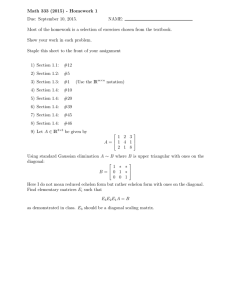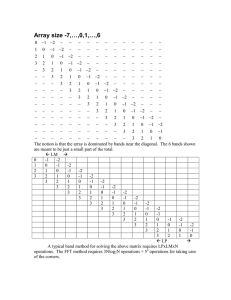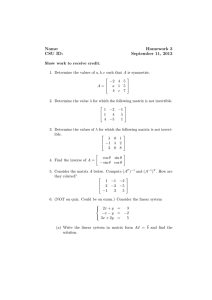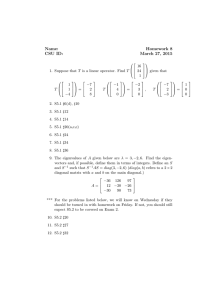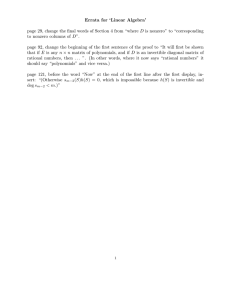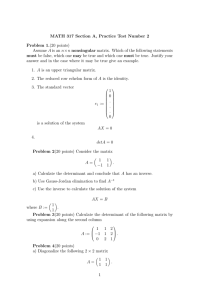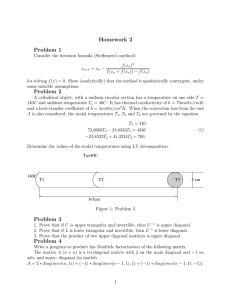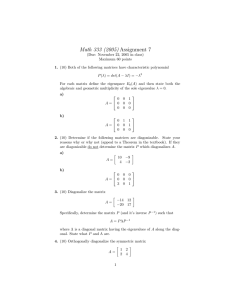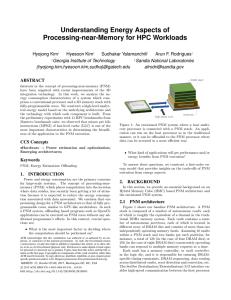( ) 12 - 1 Lecture 5.73
advertisement
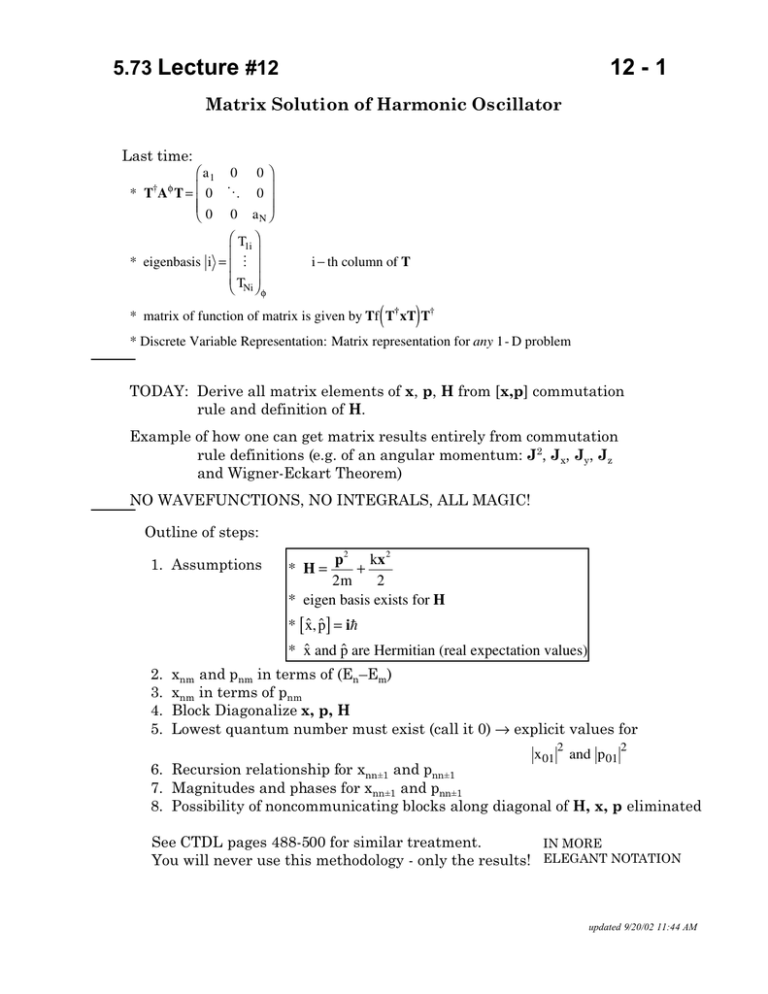
5.73 Lecture #12 12 - 1 Matrix Solution of Harmonic Oscillator Last time: a1 0 0 * T A T= 0 O 0 0 0 aN † φ T1i * eigenbasis i = M T Ni φ i − th column of T ( ) * matrix of function of matrix is given by Tf T† xT T† * Discrete Variable Representation: Matrix representation for any 1- D problem TODAY: Derive all matrix elements of x, p, H from [x,p] commutation rule and definition of H. Example of how one can get matrix results entirely from commutation rule definitions (e.g. of an angular momentum: J2, Jx, Jy, Jz and Wigner-Eckart Theorem) NO WAVEFUNCTIONS, NO INTEGRALS, ALL MAGIC! Outline of steps: 1. Assumptions p 2 kx 2 + 2m 2 * eigen basis exists for H * H= ˆ pˆ ] = ih * [x, * xˆ and pˆ are Hermitian (real expectation values) 2. 3. 4. 5. xnm and pnm in terms of (En–Em) xnm in terms of pnm Block Diagonalize x, p, H Lowest quantum number must exist (call it 0) → explicit values for x 01 2 and p 01 2 6. Recursion relationship for xnn±1 and pnn±1 7. Magnitudes and phases for xnn±1 and pnn±1 8. Possibility of noncommunicating blocks along diagonal of H, x, p eliminated See CTDL pages 488-500 for similar treatment. IN MORE You will never use this methodology - only the results! ELEGANT NOTATION updated 9/20/02 11:44 AM 5.73 Lecture #12 12 - 2 1. recall assumptions 2. x and p matrix elements derived from Comm. Rules p2 1 2 1 1 + kx = x,p2 = [ x,H] = x, (p[x,p] + [x,p]p) 2m 2m 2 2m [ ] ** [ x,p] = ih → [ x, H ] = p ih 2ih = p 2m m m p = [ x,H] ih take matrix elements of both sides, insert completeness between x and H m p nm = ∑ ( x nl H lm − H nl x lm ) ih l [ ] similarly, starting from [p, H] = p, 12 kx 2 = −ihkx x nm = i ∑ ( p nl H lm − H nl plm ) kh l but we know that some basis set must exist where H is diagonal. Use it implicitly: ∴ replace Hlm by Emδml m p nm = ( x nm E m − E n x nm ) ih m p nm = x nm ( E m − E n ) ih ∴ pnn = 0 (but, in addition, if H has a degenerate eigenvalue, then pnm = 0 if En = Em) similarly for x nm = i p nm ( E m − E n ) hk ∴ xnn = 0 (and xnm = 0 if En = Em) updated 9/20/02 11:44 AM 5.73 Lecture #12 12 - 3 3. solve for xnm in terms of pnm multiply the x nm equation by p nm multiply the p nm equation by x nm equate RHS: The LHSs of both resulting equations are equal i 2 m 2 x nm ( E m − E n ) = p nm ( E m − E n ) ih hk * If En = Em (degeneracy) – then we already know that xnm = 0, pnm = 0 1 2 * If En ≠ Em x 2nm = − p nm km x nm = ±i(km)−1/ 2 p nm THERE IS A PHASE AMBIGUITY HERE! m x nm ( E m − E n ) ih m ±i( km )−1/2 p nm ( E m − E n ) plug in new result for xnm p nm = ih Either earlier we derived p nm = ( (OK to divide thru by pnm ) * ) p nm ≠ 0 AND E m − E n = ± h( k m ) 1/ 2 ≡ ± hω !! OR * p nm = 0 ⇒ x nm = 0 The only non-zero off-diagonal matrix elements of x and p involve eigenfunctions of H that have energies differing by exactly hω! A “selection rule”! The only nonzero matrix elements of x and p are those where indices differ by ±1. updated 9/20/02 11:44 AM 5.73 Lecture #12 12 - 4 4. x, p, H are block diagonal ized In what sense? There is a set of eigenstates of H that have energies that fall (1) onto the comb of evenly spaced E n E (1) n = n( hω ) + ε1 could be another set E (2) n = n( hω ) + ε 2 where ε 2 − ε1 ≠ nhω all n but within each set, there must be a lowest energy level Set I E(1) 0 is lowest I II E1(1) = E(1) 0 + hω etc. Set II E (2) 0 is lowest E1(2) = E(2) 0 + hω interleaved but noncommunicating? etc. Since x and p have nonzero elements only within communicating sets for H, thus x, p, H are block diagonalized into sets I, II, etc. I 0 0 0 0 II 0 0 H, x, p = 0 0 III 0 0 0 0 O We will eventually show that all of these blocks along the diagonal are identical (and that each energy level is nondegenerate). If x, p are block diagonal, then x2, p2 are similarly block diagonal. updated 9/20/02 11:44 AM 5.73 Lecture #12 12 - 5 5. A lowest index must exist within each block. Call it 0. [x,p] = ih is a diagonal matrix ∑ (x nl plm − p nl x lm ) = ihδ nm l ih = ( x nn+1p n+1n − p nn+1x n+1n ) + ( x nn−1p n−1n − p nn−1x n−1n ) must be equal These are the only surviving nonzero terms in the sum over l! but there must be a lowest Ei because E = T + V and T ≥ 0, E ≥ Vmin let n = 0 be lowest index p0,–1 = x0,–1 = 0 x 01p10 − p 01x10 = ih used Hermiticity here ( ) x,p are Hermitian A = A† thus x 01p*01 − p 01x*01 = ih previously x nm = ±i( km )−1/2 p nm (note that the same symbol is used for mass and basis state index) we must make phase choices so that x and p are Hermitian updated 9/20/02 11:44 AM 5.73 Lecture #12 12 - 6 phase ambiguity: we can specify absolute phase of x or p BUT NOT BOTH because that would affect value of [x,p] BY CONVENTION: matrix elements of x are REAL p are IMAGINARY tryx = + i ( km) −1/2 p and eliminate p by plugging this into 01 01 01 * * − p01 x01 = ih x01 p01 get x 01 p 01 2 2 −1/ 2 h = ( km ) 2 = +1/ 2 h km ( ) 2 If we had chosen x 01 = −i( km )−1/ 2 p 01 we would have obtained x 2 = − h ( km )1/ 2 which is impossible! 01 2 two things that must be checked for self-consistency of seemingly arbitrary phase choices at every opportunity: * Hermiticity * 6. Recursion Relation for x ii+1 2 2 ≥0 start again with general equation derived in #3 above using the phase choice that worked in #5 above x nn +1 = − i( km )−1/ 2 p nn +1 index going up Hermiticity c.c. of both sides x*n+1n = i( km )−1/2 p*n+1n x n +1n = − i( km )−1/ 2 p n +1n index going down updated 9/20/02 11:44 AM 5.73 Lecture #12 12 - 7 ∴ x nn±1 = ±i( km )−1/2 p nn±1 now the arbitrary part of the phase ambiguity in the relationship between x and p is eliminated Apply this to the general term in [x,p] ⇒ lots of algebra NONLECTURE : from four terms in [x,p] = ih ( km )1/2 * x nn+1p n+1n = x nn+1p*nn+1 = x nn+1 − x nn+1 i = x nn+1 2 (+i(km)1/2 ) ( km )1/2 2 −p nn+1x n+1n = − x nn+1 x*nn+1 = x nn+1 +i( km )1/2 i ( ( ) ) ( km )1/2 * x nn−1p n−1n = x nn−1p*nn−1 = x nn−1 + x nn−1 i = x nn−1 2 (−i(km)1/2 ) ( km )1/2 2 −p nn−1x n−1n = − − x nn−1 x*nn−1 = x nn−1 −i( km )1/2 i ( ( ) combine 4 terms in [x,p] = ih to get [ 2 ∴ ih = 2i( km )1/2 x nn+1 − x nn−1 h(km)−1/2 2 + x nn−1 2 2 2 h but x 01 = x10 = ( km )−1/2 2 2 ) ] 2 x nn+1 = each step up produces another additive term: thus recursion relation h 2 h 2 x nn+1 = ( n + 1) ( km )−1/2 2 h 2 p nn+1 = ( n + 1) ( km )+1/2 2 ( km) −1/2 general result updated 9/20/02 11:44 AM 5.73 Lecture #12 12 - 8 7. Magnitudes and Phases for xnn±1 and pnn±1 verify phase consistency and hermiticity for x and p in # 3 we derived x nn±1 = ±i( km )−1/2 p nn±1 one self1/2 consistent set is h 1/2 x nn+1 = +( n + 1) = +x n+1n 2( km )1/2 x real 1/2 and h 1/2 = +x nn−1 positive x nn−1 = +( n ) 2 km 1/2 ( ) AND p imaginary with sign flip for up vs. down 1/2 1/2 p nn+1 = −i( n + 1)1/2 h( km ) = −p n+1n 2 1/2 1/2 1/2 h( km ) = −p n−1n p nn−1 = +i( n ) 2 Note that nonzero matrix elements of x and p are always ∝ [larger quantum number]1/2 This is the usual phase convention Must be careful about phase choices because one never really looks at wavefunctions, operators, or integrals 8. Possible existence of noncommunicating blocks along diagonal of H, x, p you show that H nm k = ( n + 1 / 2)h m 1/2 δ nm note that x 2 and p2 have nonzero ∆n = ±2 elements but 2 1 kx 2 + p has cancelling contributions in ∆n = ±2 locations 2 2m This result implies all of the possibly independent blocks in x, p, H are identical * εi = (1/2)hω for all i * degeneracy of all En? all En must have same degeneracy, but can’t prove that it is 1. * updated 9/20/02 11:44 AM

